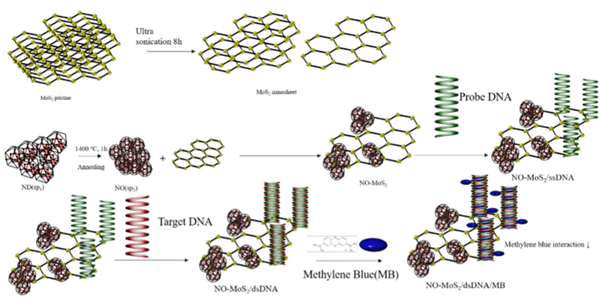The electrochemical sensor, made of a graphitic nano-onion/molybdenum disulfide nanosheet composite, detects human papillomavirus (HPV)-16 and HPV-18, with high specificity.
 Chung-Ang University researchers have developed a novel electrochemical nano-onion/molybdenum disulfide nanosheet composite-based DNA biosensor that efficiently and specifically detects human papillomavirus (HPV)-16 and HPV-18, enabling early diagnosis of cervical cancer. Image Credit: Journal of Nanobiotechnology
Chung-Ang University researchers have developed a novel electrochemical nano-onion/molybdenum disulfide nanosheet composite-based DNA biosensor that efficiently and specifically detects human papillomavirus (HPV)-16 and HPV-18, enabling early diagnosis of cervical cancer. Image Credit: Journal of Nanobiotechnology
Diagnosis of cervical cancer involves detection of target DNAs produced from human papillomavirus (HPV)-16 and HPV-18. Recently, researchers from Chung-Ang University developed an electrochemical DNA biosensor with enhanced sensitivity for effective HPV detection with high specificity. They achieved this feat using a graphitic nano-onion/molybdenum disulfide nanosheet composite with improved conductive electron transfer compared to the nanosheet alone. Their breakthrough can open doors to the development of electrochemical biosensors for early diagnosis of various ailments.
Molybdenum disulfide (MoS2) has recently garnered attention among materials science researchers owing to its ability to form two-dimensional nanosheets like graphene. The nanosheets are created by the stacking of S–Mo–S layers interacting via Van der Waals interactions. Additionally, the unique structural, optical, thermal, and electrochemical properties of MoS2 have opened up multiple research avenues across several fields, including the development of biomolecule sensing and chemical detection platforms, optoelectronics, supercapacitors, and batteries.
Traditionally, carbon nanostructures have been employed as an immobilization platform for DNA. In order to substitute carbon with MoS2 as an effective electrochemical DNA sensor, the electrical conductivity of MoS2 needs to be improved considerably. Against this backdrop, Associate Professor Eunah Kang and Mr. Youngjun Kim from the School of Chemical Engineering and Material Science at Chung-Ang University, Korea have recently come up with an elegant solution. The duo has developed an electrochemical DNA biosensor using a graphitic nano-onion/molybdenum disulfide (MoS2) nanosheet composite, which effectively detects human papillomavirus (HPV)-16 and HPV-18, and can serve as an early diagnosis of cervical cancer.
“Nano-onions possess graphitic sp2 structures and are derived from crystalline sp3 nanodiamonds via thermal annealing or laser irradiation,” explains Dr. Kang. Their breakthrough was published in Volume 21 of the Journal of Nanobiotechnology on 10 June 2023.
The researcher duo prepared the novel electrode surface for probing DNA chemisorption by enabling chemical conjugation between two functional groups: acyl bonds on the surfaces of functionalized nano-onions and amine groups present on the modified MoS2 nanosheets. Cyclic voltammetry experiments revealed that a 1:1 composite electrode had an improved rectangular shape compared to that of an MoS2 nanosheet electrode. “This indicated the amorphous nature of the nano-onions with curved carbon layers that facilitated an enhancement in electronic conductivity compared to MoS2 nanosheet alone,” highlights Dr. Kang.
Additionally, the duo measured the sensitivity of their novel electrochemical DNA biosensor device towards HPV-16 and HPV-18 by employing differential pulse voltammetry (DPV) technique in the presence of methylene blue (MB) as a redox indicator.
The DPV current peak was lowered after probe DNA chemisorption and target DNA hybridization. Since the hybridized DNA was double-stranded, it induced less effective MB electrostatic intercalation, resulting in a lower oxidation peak.”
Eunah Kang, Associate Professor, School of Chemical Engineering and Material Science, Chung-Ang University
The duo found that, compared to the MoS2 nanosheet electrode, the nano-onion/MoS2 nanosheet composite electrode attained higher current peaks, indicating a greater change in the differential peak. This was attributed to an enhanced conductive electron transfer owing to the nano-onion.
Notably, the target DNAs produced from HPV-16 and HPV-18 Siha and Hela cancer cell lines were detected by the proposed sensor effectively and with high specificity. Consequently, MoS2 nanosheets with improved electrical conductivity facilitated by complexation with nano-onions provides a suitable platform for developing effective and efficient electrochemical biosensors for the early diagnosis of a wide variety of ailments, including cervical cancer.
Furthermore, combining nano-onions or nanodiamonds with different organic biomaterials can facilitate chemical functionality, electron transfer conductivity, light absorption, and more. These, in turn, can lead to innovative disease sensing, targeted drug delivery systems, and biomedical imaging and diagnostics.